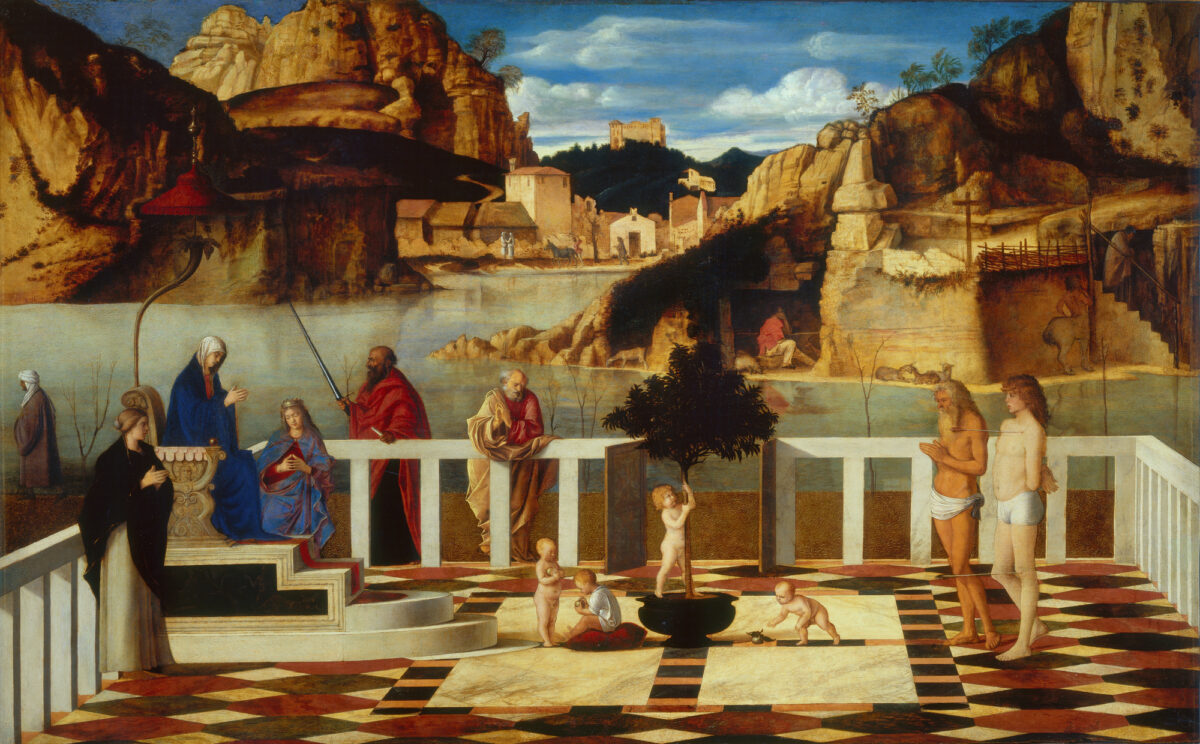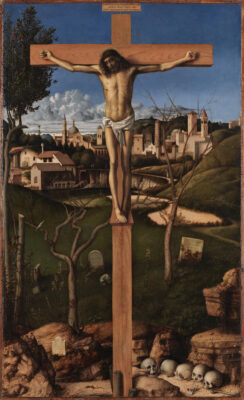
At the Getty Museum – “Giovanni Bellini: Landscapes of Faith in Renaissance Venice”
From what I understand, this is the first monographic or solo exhibition devoted to Bellini in this country, which often is a polite way of saying that an artist may be good but he ain’t great. However, we’ll quickly dispel such a notion.
In the accountable words of Davide Gasparotto, senior curator of paintings at the Getty Museum, curator of this exhibition, and editor of the accompanying catalogue, Bellini “is universally acknowledged as being the founding father of Venetian Renaissance painting and one of the greatest Italian artists.”
An essay by Daniel Wallace Maze in the same catalogue also minces no words: “Art historians widely recognize Bellini as the greatest artist of fifteenth-century Venice and vital to the development of Venetian Renaissance painting, which plays a central role in the history of Western art.”

For all that, not a great deal is known about Giovanni Bellini himself. He was born around 1435 and died in 1516 and, as Maze writes, “was principally bound to the well-defined subjects of Christian art. For Bellini, painting might have been a cathartic act, but art cannot yet express Bellini’s own personal catharsis.”
As the above paragraph implies, Bellini composed a fair amount of religious work, and nearly every piece in the show gives us either a Christ or a Madonna (sometimes both together) or a Saint Jerome. The latter can signify different things to different people, but to Bellini, according to Hans Belting, “Saint Jerome represents the hermit as the model of a solitary life to be lived in the bosom of nature.”
In several paintings, Bellini depicts the ill-clad saint immersed in an oversized tome, sitting among crags and boulders and often with a town or settlement far away in the distance. It’s quite a different take from Antonello da Messina’s well-known “Saint Jerome in His Study,” in which the well-dressed saint sits at his desk in what seems a clean, spacious building. It’s as if Bellini has taken Jerome to Twentynine Palms whereas Messina has settled him in Brentwood.
However, what you’ll notice in practically every portrait of Saint Jerome, or at least in those worth their salt, is the compliant or complaisant lion. What Friday was to Robinson Crusoe, the lion was to Jerome after the saint extracted a thorn from its paw, thus representing compassion overwhelming brute force (and the fear of being eaten). It would, of course, be interesting to get all this from the lion’s point of view, but in the meantime…
Bellini’s pictures were typically commissioned by sophisticated and presumably well-to-do patrons. They served as devotional works, as an aid to prayer or meditation. With their traditional Christian subject matter, they were often set “in luminous, dreamy landscapes in which the viewer is free to wander from one motif to another.”

Gasparotto shows us how “Bellini constructed his landscapes, whose apparent naturalness is the result of a calculated blend of reality and imagination, of meticulous observation of the real world and invention, as he was inspired by and vied with tradition and the painting of his own age.” This is true in particular with many of the secondary elements inserted into the background narrative.
Among the artists who directly or indirectly influenced and inspired Bellini was his father Jacopo (who, some conjecture, may actually have been an older brother), his brother-in-law Andrea Mantegna, the aforementioned Antonello da Messina, and such Flemish painters as Jan Van Eyck and Dieric Bouts the Elder. On the other end of the spectrum, Bellini’s late works foreshadowed the idyllic, Arcadian landscapes of Giorgione and Titian. Good company, all the way around.
Perhaps the most intriguing work in the exhibition, and certainly the most enigmatic, is titled “Sacred Allegory” (c.1500-1504), which in itself is vague or noncommittal. As John Pope-Hennessy put it, “No one looking at the picture can doubt that it has a programmatic source which has not been identified.” It’s a medium-sized horizontal work with a dozen varied Biblical figures in the foreground, plus other varied figures (including a centaur) in the midfield, and with buildings–and more figures–in the background. We get the idea that quite a bit is being said or expressed, and yet everything’s mute.
Although this is an important show, it’s also small and yet succinct: Just 12 paintings and one drawing. The gallery space, with its subdued lighting and deep green walls, may give us the impression of stepping into a grotto or some sort of sanctuary. And actually it’s quite conducive to the devotional nature of the work itself.
The catalogue is slim but informative, and includes additional work by Bellini not on view here (the magnificent “Portrait of Doge Leonardo Loredan,” for example) as well as examples of work by the other artists mentioned above. Religious pictures, of whatever era, aren’t always a large draw, but this show merits our attention and for many viewers will serve as a fine introduction or a timely reminder of an important figure in art history..
“Sacred Landscapes: Nature in Renaissance Manuscripts”

The catalogue for the show, from which I’m quoting, was written by Brian C. Keene, an assistant curator of manuscripts at the Getty, and Alexandra Kaczenski, a former graduate intern in the Getty’s manuscripts department. Both authors also curated the show. Additionally, Keane is the author of “Gardens of the Renaissance” (and, I believe, curated the 2013 show of the same name). The current exhibition is also something of a sequel to “Illuminating Women in the Medieval world,” another succinct collection of illuminated manuscripts that was recently on display at the Getty.
As the Getty’s director Timothy Potts writes in the foreword to the catalogue, “During the Renaissance, European artists painted spiritually uplifting landscapes to exhilarate viewers and enhance religious experience.” The artists include the Dutch Limbourg brothers (they of the “Très Riches Heures”) and Jean Fouquet. What makes the work stand out, however, is that, pressed into books, the brilliant colors have been preserved.

The accent is really on greenery, which has traditionally been soothing for the eye and the mind, whereas the desert and rocky environment (as we can see in Bellini’s work) often serves to test the will, the endurance, and religious convictions of those ascetics, Saint Jerome among them, who ventured there.
Among the many details we may notice is that religious pictures, although depicting events around or near the birth of Jesus Christ, often include people in what would have been contemporary dress. Or, as the authors write, “Northern Renaissance artists often incorporated scenes of everyday life into religious sequences in order to locate the figure in history, make the scenes accessible to contemporaneous viewers, and suggest the sacred can be found in the quotidian.”
Those so inclined, in order to grasp more of the inner content of the art, should consider an earlier Getty publication entitled “Nature and Its Symbols.” It’ll help you with both shows, that is to say, the A-side and the B-side, comprising these two concise, condensed, enlightening exhibitions.
Giovanni Bellini: Landscapes of Faith in Renaissance Venice and Sacred Landscapes: Nature in Renaissance Manuscripts are on view through Jan. 14 at the Getty Center, 1200 Getty Center Drive, Los Angeles. Free; parking $15 ($10 after 3 p.m.). Closed Christmas Day and New Year’s Day. (310) 440-7300 or go to getty.edu. ER










